Culture of Zambia

Culture Name
Zambian
Alternative Names
Republic of Zambia
Orientation
Identification. Zambia derives its name from the Zambezi River. The river runs across the western and southern border and then forms Victoria Falls and flows into Lake Kariba and on to the Indian Ocean.
Location and Geography. In size, the country is roughly equivalent to the state of Texas, about 290,585 square miles (752,615 square kilometers). The unique butterfly-shaped boundaries are the result of the European scramble for Africa's natural resources in the early 1900s. The capital is Lusaka. Bordering neighbors are the Democratic Republic of the Congo, Tanzania, Malawi, Mozambique, Zimbabwe, Botswana, Namibia, and Angola.
It is a landlocked country with several large freshwater lakes, including Lake Tanganyika, Lake Mweru, Lake Bangweulu, and the largest man-made lake in Africa, Lake Kariba. The terrain consists of high plateaus, large savannas, and hilly areas; the highest altitude is in the Muchinga Mountains, at 6,000 feet (1,828 meters). The Great Rift Valley cuts through the southwest and Victoria Falls, the most visited site in Zambia, is in the South.
There are several game parks in the country; some consider Southern Luangwa to be the best game park on the continent.
Demography. The population in 2000 was estimated at 9.87 million. There exists a strong migration to urban areas where families go looking for employment. With 43 percent of the population living in cities, Zambia has the highest ratio of urban population in Africa. Those living in the rural areas face a life of mainly low-yielding subsistence farming, which contributes to the high migration.
The population is comprised primarily (97 percent) of seven main tribes and a collection of seventy-five minor tribes. There is also a small percentage of citizens from other African nations. The remaining population is of Asian, Indian, and European descent. Because of conflicts in the border countries of the Democratic Republic of the Congo and Angola, there has been a large influx of refugees in recent years.
Linguistic Affiliation. English is the official language as the country was once an English colony (1924–1964). While many people speak English, in rural areas tribal languages are spoken, in addition to a few other vernacular languages. Each of the seventy-five tribes living in the country has its own dialects and language. The main vernacular languages are Bemba, Lozi, Luanda, Luvale, Nyanja, Tonga, and Tumbuka.
Symbolism. The background of the national flag is green, symbolic of the country's natural beauty, with three vertical stripes in the lower right corner. The three stripes are: red, symbolic of the country's struggle for freedom; black, representing the racial makeup of the majority population; and orange, symbolic of the country's copper riches and other mineral wealth. A copper-colored eagle in the upper right corner symbolizes the country's ability to rise above its problems.
Zambia is noted for its rich wildlife and landscapes, using those resources to promote tourism with the slogan, "the Real Africa." The most notable landmark is Victoria Falls, known locally as Mosi-oa-Tunya, which means "the smoke that thunders." It is one of the seven natural wonders of the world and even though it is shared with Zimbabwe, it is a source of great pride for Zambians.
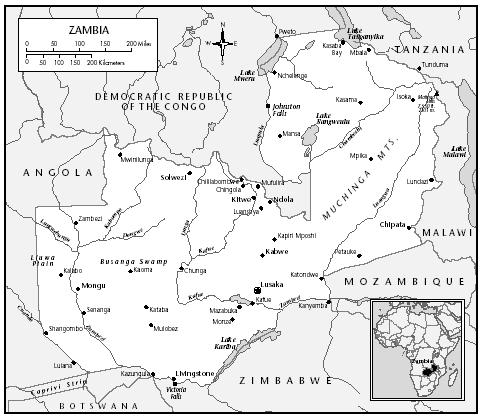
Zambia
For many years, the saying "Copper is king" was symbolic of the country because copper was the main contributor to the economy.
History and Ethnic Relations
Emergence of the Nation. One of the cradles of the human race is in the northern African Rift Valley, which includes modern-day Zambia. This area traces human settlement back almost three million years. In Zambia, sites in the north and south record back to sixty thousand years ago.
Tribal migrations in only the past three hundred years have determined the makeup of present-day Zambia. Between 1500 and 1800 the Lunda and Luba people traveled from the Congo and became a powerful group. The Ngoni, originally from South Africa, escaped from the Boers and Zulus and settled in Eastern Zambia around 1850–1870. Another powerful tribe, the Lozi, dominated western Zambia and also originated from the Congo in the late seventeenth century. By the beginning of the twentieth century, these tribal migrations had transformed the area into a complex society tied together by conflicts and trade.
In the late 1800s, Portuguese and Muslim traders moved further inland and established trade with tribes. The main items were gold, ivory, and slaves. It was also at this time that missionaries established themselves, the most famous probably being David Livingstone. He worked hard to stop the slave trade and opened the door for the British who wanted to prevent the Portuguese from occupying the land and connecting Angola to Mozambique. Livingstone died in the Bangweulu Swamps in 1873 after exploring much of the area that is now Zambia.
Livingstone's exploring was tied directly into British colonial history and "the scramble for Africa." Cecil Rhodes founded the British South Africa Company (BSAC), which wanted to connect the "Cape to Cairo." Rhodes quickly became one of the wealthiest men in southern Africa. In 1898 he was granted a charter by Queen Victoria to govern the territory then under British control. Under the belief that there were gold and minerals along the Zambezi River, he financed British expansion into these areas. The BSAC established its headquarters in the town of Livingstone.
In 1929 the British government took back control and made the area a protectorate named Northern Rhodesia. The capital was moved to Lusaka in 1935. At this time large copper and other mineral deposits (including gold) were found in the Copperbelt, a province in the north central region. The mines became the driving force for the settlement and expansion of the country as a whole. To fill jobs in the mines, Zambians came from all over the country and settled in urban areas.
In 1953 the British Colonial Office decided to unite Nyasaland (Malawi), Southern Rhodesia (Zimbabwe), and Northern Rhodesia into the Central African Federation. There was strong opposition to the federation because a substantial amount of money was funneled out of Northern Rhodesia to support Southern Rhodesia. The struggle against the federation soon turned into one for freedom as the independence fever swept across Africa. Strikes by mine workers turned into a power base that formed the United National Independence Party (UNIP), led by Kenneth Kaunda. Civil disobedience organized by the UNIP led the British government to allow elections. The republic of Zambia gained its independence on 24 October 1964 with Kaunda as the first president.
National Identity. The people retain strong ties to their tribe or clan, but there is also a strong national identity. Zambia became a settling ground for many migrating tribes around 1500 to 1700, and those immigrants helped create a crossroads of culture in the country. These tribes have lived in harmony with each other for decades. When the first president, Kenneth Kaunda, introduced the slogan "One Zambia, One Nation," it was considered a strong symbol of the country's unified national identity.
Ethnic Relations. The seventy-five tribes that make up Zambia coexist relatively well in comparison to tribes in neighboring countries who were purposefully pitted against each other as part of the colonial governing policies. In these calculated cases, the minority tribe would usually develop primary power; this would only fuel tribal hatred. In some countries, that animosity still exists and creates major social problems.
The main tribes in Zambia are Bemba, Nagoni, Lozi, Chewa, Chokwe, Lunda, Luvale, Tonga, and Tumbuka. Most Zambians have joking relations with other tribes; the relationships go back many years. For example, a Bemba may throw verbal abuses to a Nyanja, but this is done in jest for the most part. This is an important distinction from other countries, where greater animosity exists. Zambians may consider their tribe superior to another, but there is an overall sense of unity across all groups.
Another factor in these good relations is the large urban population. The vast bush regions provide for a great deal of open land and tribes generally do not infringe on one another. In the cities, there is a strong interaction between the tribes. Some members choose to marry out of their own tribes, which strengthens the ties between the different groups. The flip side is that Zambian society has become more homogenized.
Urbanism, Architecture, and the Use of Space
There is a trend to move away from vernacular building styles and techniques to more modern or Western ways of construction. Traditionally, the type of building depended on the availability of materials. For example, basket-weaving construction can be found in homes of the eastern province, while construction using mud-covered small branches can be found in the rest of the country. Construction also depends on the tribe's customs. The Lozi in the southwest build rectangular houses, while the Chewa favor circular structures. Most of the roofs are made of poles and thatch.
A great change occurred with the influence of missionaries and European colonists. The settlers built using Western standards. The missionaries introduced the burnt brick, used to build into square structures, while the colonists built wood-frame structures with metal roofs. These proved to be quite hot, and adaptations were made, incorporating large roofs to allow for ventilation, and spacious verandas to capitalize on the breezes. Examples of colonial architecture can still be seen in Livingstone as well as some examples of Cape Dutch influence from South Africa.
When the British reigned over the countryside, they established British Overseas Management Areas (BOMAs), or small towns that were seats of government and business. Towns were laid out using a grid system. Villages were different, varying from tribe to tribe. The Chewa would form a village in a crescent-moon shape with the chief's lodging in the center. The Lozi developed large homesteads enclosed in a fence. This was for protection from warring tribes, as well as safety for the tribe's cattle.
A homestead usually consists of a main house, other houses, a social insaka, a cooking insaka, and other functional structures such as latrines or granaries. An insaka is a small roofed structure that is similar to a gazebo.
Food and Economy
Food in Daily Life. The availability of food supplies depends on season and location. The main staple is nshima, which is made of maize (corn). "Mealie meal" is dried and pounded corn to which boiling water is added. It is cooked to a consistency of thickened mashed potatoes and is served in large bowls. The diner scoops out a handful, rolls it into a ball and dips it into a relish. The preferred relish is usually a meat—goat, fish, or chicken—and a vegetable, usually rape (collard greens) and tomatoes, onions, or cabbage. In rural areas, where meat is not an option on a regular basis, nshima is served with beans, vegetables, or dried fish. Mealie meal is eaten three times a day, at breakfast as a porridge and as nshima for lunch and dinner. Buns are also popular at breakfast, taken with tea.
Other foods, such as groundnuts (peanuts), sweet potatoes, and cassava, are more seasonal. Fruits are plentiful, including bananas, mangoes, paw paws, and pineapples, which come from the hilly regions.
In the cities, there are plenty of fast-food establishments or "take-aways" that serve quick Western food such as sausages, samoosas (savory-filled pastries), burgers, and chips with a Coca-Cola. There are also an increasing number of formal Western-style restaurants that are largely accessible only to the wealthy.
Food Customs at Ceremonial Occasions. Food customs vary among tribes. For example, in the Bemba culture it is taboo for a bride to eat eggs because it may affect her fertility. Another Bemba tradition is to serve the newlyweds a pot of chicken whose bones are then replaced in the pot and given to the bride's mother. A Lozi tradition is to eat porridge off of a stone to bless the couple. Most ceremonies, including weddings, funerals, and initiation ceremonies, involve lots of food and traditionally brewed beer.
Basic Economy. Starting with the rural community, life is supported primarily by subsistence farming. Most villagers have a small plot of land on which they farm maize, groundnuts, cassava, millet, sweet potatoes, and other products. Some villagers organize larger fields to support the community and groups of women may grow their own crops for sale.
The eastern part of the country has a climate suitable for the growing of cotton; coffee is grown in the north. Communities near lakes focus on fishing as a major industry, selling their catch all over the country. Zambia is host to a variety of freshwater fish species, including kapenta and bream. In areas where water is scarce, cattle and other domestic animals are raised.
While industrial manufacturing is limited, many everyday products are produced in the country, such as candles, cooking oil, and matches. People in the smaller urban areas may have small shops or a stand in the local marketplace, selling produce or providing a service such as watch repair. The market is a place not only of trade but of socialization. But while some may be able to support themselves and their families on the farm or in the village, job opportunities in the larger urban areas continue to contribute to the urban migration taking place in the country.
Land Tenure and Property. There are many plots of land, both in cities and rural areas, that are owned by individuals after purchase from the government. In the villages, the chiefs own the land and give out parcels to their supporters. In this distribution, tribal customs and practices are honored. The government supports this form of distribution because the acreage to be distributed is vast and unpopulated. The government still owns most of the valuable land, specifically the mines and other mineral-rich areas.
In the large urban areas, there is a huge housing crisis. Shantytowns have been erected with no sewage and the majority lack electricity. The occupants of these areas are squatters who do not own the land but who have established their homes there and indeed, whole communities.
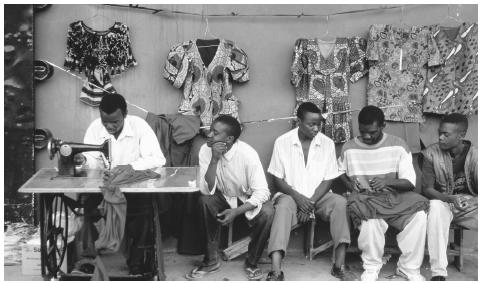
A tailor's stall market in Lusaka, Zambia. The stall is not only the tailor's business, but it is also a place to socialize.
There are no laws preventing ownership of land by women. Very few women own land in practice primarily because of cultural and historical precedent.
Ten percent of all the land is demarcated by the government for private ownership and most of that is located in the cities. The corridors of development that do exist appear along railways and highways, which are also demarcated, usually by large farmers who want to be tied into the transportation system.
Commercial Activities. Some of the locally produced agricultural products are sold domestically, along with some household goods, cloth, and other food items. In the years of Kaunda, there was an attempt to locally make the goods needed by the country. Zambia also had an agreement with the government of the People's Republic of China, who built the Tarzara railway, connecting Zambia to Dar es Salaam, Tanzania, and the rest of the world. Because Zambia is landlocked, this link helped out with the limited trade that did occur. When democracy was ushered in, President Frederick Chiluba opened the Zambian doors to trade. Since that time, there has been a heavy influx of goods from England, Japan, the United States, and, primarily, South Africa, whose products have flooded the market and are very popular with Zambians.
Major Industries. The copper mines have traditionally provided for a major part of the economy. In 1996, copper accounted for 80 percent of all exports. A major portion of the mines were opened to privatization, but the government was still working to sell them off. Mines were sold because of years of mismanagement and financial corruption.
Zambia has great agricultural potential and many large-scale farms have been established. The infrastructure for the distribution of goods, though, is very poor and poses a major obstacle for economic advancement in this area.
The country does support some unique industries, such as a flourishing cement trade that exports primarily to Zambia's neighbors. Farms outside of Lusaka also export roses, and are a leading supplier to the European market.
In 1995, 70 percent of the labor force was in agriculture, 18 percent in services, and 12 percent in industry.
Trade. The main exports are copper, cobalt, zinc, tobacco, maize, and emeralds. The primary recipients are South Africa, Japan, and Saudi Arabia. The
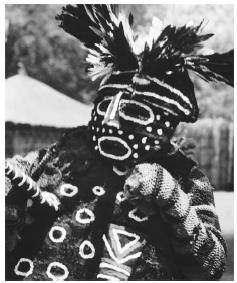
A woman wears a mask made of bark fibers, in preparation for an initation ceremony, Zambia.
main imports are automobiles, farming equipment, chemicals and fuels, and food items, from South Africa, Japan, Europe, and the United States.
Division of Labor. Labor is primarily divided between rural and urban workforces. In urban areas, jobs obtained are related to an individual's educational levels. There is high unemployment in the cities, with better-paying jobs found in government work, large businesses, and with nongovernmental organizations (NGOs). These jobs are held by people with higher education, especially those who had schooling overseas. The poor, lessertrained individuals who come to the cities may manage to earn a living by doing odd jobs or owning a small shop.
Social Stratification
Classes and Castes. Since independence came to Zambia, there has been an obvious gap between the rich and the poor. The elite have adopted a Western standard of living and in essence have created their own class. In both rural and urban societies, there are definite lines of wealth and poverty. In the village a man is considered wealthy by having a large, healthy family, as well as his material goods. In the cities, there is greater emphasis on material wealth.
The white and Asian populations have traditionally owned businesses and have done well over the years.
With the loosening of trade restraints, the gap between rich and poor has only widened. At the same time, the government is working to increase foreign investment in the country, while national priorities such as education and health care declined in importance.
Symbols of Social Stratification. Concrete blocks and tin roofs—once provided by the government for palace construction within the villages—became a symbol of wealth and prestige. If a family did well financially, they would attempt to copy this construction fashion.
In small cities where electricity is available, appliances such as refrigerators, stoves and especially televisions and video cassette recorders are an indication of wealth. In all communities, a vehicle is an obvious indicator of wealth and success. In the cities, foreign imports are frequent sights on the streets.
An individual's house is also a symbol of wealth and success. In the cities, large houses with pools and manicured gardens enclosed in a large fence can be found. In the villages, a family's homestead reflects wealth through the number of structures, particularly if those structures include granaries, which hold a family's maize harvest.
Political Life
Government. The first president, Kaunda, came to power in 1964. He soon banned all other political parties and established what he called "Zambian Humanism," which was loosely based on socialist ideas. The country faired well because of the price of copper. Because of economic hardships and pressure from foreign countries, Kaunda eventually allowed for multiparty elections. Chiluba was the second president, winning the elections under the Movement for Multiparty Democracy (MMD). He encouraged open trade relations which led to increased economic activity. With the new elections, a declaration of independence was created that included a bill of rights for every citizen.
A president is elected for five years and cannot serve more than two terms. In 1996 the country was criticized for holding unfair elections.
The legal system is modeled after English common law and customary law. The judicial branch includes a supreme court with justices appointed by the president. The vice president is also appointed by the president.
Leadership and Political Officials. Government jobs are highly coveted because of the pay and other associated benefits that might include cars, houses, and even travel. Political power, as in other governments, is related to loyalty to the presidential administration and shifts in that power do occur.
In rural areas, political control is directed by the village chiefs or chieftainesses. Some of these rural rulers have immense power, wealth, and influence while others do not. Traditionally, the chiefs and chieftainesses ruled vast amounts of land and people. They held great power, and the British, while in control of the country, allowed for local rule in remote areas. This political structure is still in place today.
Social Problems and Control. AIDS is a major concern not only for sub-Saharan Africa but especially in Zambia, where the caseload is particularly high. The disease has led to a huge orphan crisis, creating an overburden on an already stressed medical system. Efforts to combat this disease are being made, but resources are scarce.
Refugees from warring neighboring countries also have had an impact on the government's ability to deliver human services. In 2000, government-sponsored camps held 200,000 refugees (United Nations High Commissioner for Refugees figure) from the wars in the Democratic Republic of the Congo and in Angola.
Crime is a growing problem for the country, with violent robberies and car-jacking incidents not uncommon. In villages and sometimes urban areas, a thief may find himself the victim of an angry crowd if he is unlucky enough to be caught before the official police show up. Government corruption is another problem that is crippling the country at all levels. From bribes to payoffs at a local roadblock, corruption exists. The misdirection of government funds affects everyday life when the money intended for social problems does not reach its intended use.
Military Activity. The military consists of an army and an air force but both branches suffer from inadequate funding and equipment shortages. In recent history, the troops have been used primarily for United Nations missions to the Democratic Republic of the Congo and to Angola.
There have been no major wars fought on Zambian soil. Kaunda supported Zimbabwe's fight for independence and Southern Rhodesia attacked camps in Zambia in 1978 and 1979.
In 1997, a minority faction of the military attempted a coup, but the result of that effort was a state of emergency which lasted six months.
President Chiluba traditionally has taken an active role in arranging peace talks for local conflicts as well as more international negotiations such as the Angolan conflict resolution. Zambian officials have also tried to help resolve the continuing political conflicts in the Congo.
Social Welfare and Change Programs
Once independence was achieved, copper prices made Zambia one of the wealthiest countries in Africa, which helped fund many of the subsidized government programs and products. But when copper prices dropped dramatically in the early 1970s, that income source of the government decreased and the subsidies were no longer available. With the government unable to assist, foreign aid was encouraged and some areas became dependent on that foreign support. Zambia became heavily indebted to the World Bank and the International Monetary Fund. It was pressure from these organizations that forced Kaunda to allow democratic elections.
Nongovernmental Organizations and Other Associations
Numerous nongovernmental organizations (NGOs), from various foreign countries and religious groups operate programs in Zambia. The stated goal of these organizations is to provide aid both on a large scale and at the grassroots level. One of the largest recent projects in Zambia has been a road improvement program, since transportation problems in the country are a major issue. Examples of NGOs operating in Zambia include: World Vision, Habitat for Humanity, and the International Red Cross.
Gender Roles and Statuses
Division of Labor by Gender. Both men and women work hard for basic survival. Traditionally, women have had the role of caring for the household, but in recent times, especially in cities, women work in offices, sell vegetables, and hold numerous other positions, including positions in the military. In the village, a woman's day starts out with sweeping and cleaning, followed by the collection of

A man working at a food processing plant at Kabwe. Industrial jobs are scarce, as few products are produced in Zambia. Only 12 percent of the working population is employed in industry.
water, often from long distances. The washing of clothes and the preparation of meals are also done by women. The primary responsibility for children too, falls to women, although older siblings are expected to help out with these chores.
Both women and men work long hours in the fields, although the task is largely considered men's work. The men traditionally do the fishing, hunting, and raising of livestock, but also are known to socialize more with neighbors, family, and friends. Women tend to socialize when they are doing chores.
The Relative Status of Women and Men. Men have most of the power. There has been an effort to gain greater influence for women's rights, but it is difficult to incorporate programs that change traditional beliefs. Women's groups work together in sewing or farming a small vegetable plot. This gives the women some financial gain and a voice in the family's money matters. It is also a source of pride and belonging.
Marriage, Family, and Kinship
Marriage. Traditionally, people would marry within their tribe, rarely going outside that circle to find a mate, but marriage within a clan group is considered taboo. Tribal customs vary but there usually is a mediator who serves as a go-between for a man and his desired bride. The man and his negotiator will meet with a prospective bride's family and in addition to getting to know each other, start negotiations for a lobola (dowry). This lobola traditionally involves cattle or other livestock, but in modern times money settlements have been accepted. The lobola is considered a compensation to the family for the lost services of the woman.
Christian weddings are very common even in villages, although traditional religious customs are still practiced in both cities and rural areas, with variations from tribe to tribe. A Bemba custom calls for the man to live with his bride's parents for a period, to prove his ability to take care of his wife.
Domestic Unit. The main domestic structure is the extended family, common throughout Africa. The system grew out of a need to help family members in times of trouble. For example, if a family had a year of bad crops, their relatives would be expected to provide assistance. If a mother and father died, their children would be cared for by relatives.
Inheritance. The issue of inheritance is handled differently throughout the country, reflecting the different customs of the numerous tribes. Traditional methods call for disputes to be settled within the clan or at the next level, which is the chief. In disputes involving men and women, the clans traditionally favor the male's position. In urban areas, the courts resolve these disputes. The Goba tribe has what is called dihwe, a council to settle problems of succession and inheritance if a prominent member of the household dies. Many Zambians, especially in cities, now create a will and last testament.
Kin Groups. As in most areas of Africa, clans are an important factor in Zambia society. Clans provide another way to identify one's self, in addition to tribal connections. Similar to an extended family, one is expected to assist another clan member whenever needed; it is considered part of one's social duty and identity. These kin groups are traditionally named after animals or natural features, such as crocodiles, elephants, or rain.
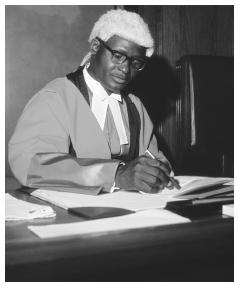
A Zambian judge overseeing a judicial tribunal in the attire of the British colonial legal tradition, Zambia.
Socialization
Infant Care. Because many families have a large number of children and since many parents work, both in rural and urban communities, a number of children are raised by their siblings. It is not uncommon in the village to see a baby being carried around by children as young as five years old.
Shitangas, which are large pieces of cloth, wrapped around the baby and the mother, allow the mother to carry the baby on her back with the baby's head peering just over her shoulder. Mothers often conduct hard labor, such as carrying water or working in the fields, while carrying an infant.
Child Rearing and Education. It is difficult for families, both rural and urban, to afford fees charged for attending school. In villages, schools are often hampered by out-of-date textbooks and buildings in terrible disrepair. There is usually an inadequate number of teachers, which forces a class schedule of only a half-day. When not in school, children are expected to be at home, helping with chores or working the fields.
Most tribes have an initiation ceremony for both boys and girls to mark an individual's entry into adulthood and official acceptance into the village. These are large events, lasting for days and celebrated with dance, food, and singing. Both male and female ceremonies involve many rituals that teach them about customs, sex, and the responsibilities of being an adult. It is usually right after these ceremonies that marriage takes place.
Higher Education. After primary school (grades one to seven), some Zambians proceed to secondary school, or grades eight to twelve. Since secondary school fees are even higher than primary school fees, some children are unable to attend. In addition to the secondary schools, the country has several boarding schools with even higher fees, but the results are a better-funded educational system. Educational resources are hard to come by and many rural schools simply must do with what they have.
After secondary school, students have limited options for furthering their formal education. There are numerous trade colleges specializing in technical programs, such as machinery, plumbing, construction, and sewing. More recently, computer programs are being offered, but these, as with other programs, specialize in basic skills for the trade fields. There also are teaching colleges that supply professionals for the Zambian school system. There are two universities: the University of Zambia in Lusaka, which specializes in liberal arts degrees, including law and business, and the Copperbelt University, in Kitwe, which offers degrees in technical subjects, such as mining, engineering, and architecture.
There have been several demonstrations by students, protesting the government's cutbacks on subsidies for school and living expenses.
In years past, these universities were well funded by the government, but deterioration has increased sharply. There is limited funding for basic things such as modern textbooks, computers, and basic building maintenance. Many Zambians choose to pursue an education out of the country and while some can afford the cost, others hope for scholarships from foreign countries, especially the United Kingdom, which has been very generous in the past. There is a concern that as many of the country's smarter students seek an education outside of the country, they will not return, opting instead to work overseas for more pay and a better standard of life.
Etiquette
Greetings are very important. One greets another by saying "hello" and "how are you?" Then come inquiries into one's family, the crops or the weather. It is rude to come directly to the point; conversations may go on for several minutes before the point of the conversation is broached.
There is hand etiquette as well. The right hand is for eating—which is traditionally done without utensils—greetings, and exchanges of money. It is impolite to use your left hand when interacting with another person. Washing of one's hands before eating is very common, with a bowl of water passed around as one sits at the table. The guests are given the honor of going first.
Proverbs are an important part of Zambian society. They are part of the oral tradition and have become catchphrases in which a lesson is taught. For example a Kaunde proverb is "Bubela bubwel," which translates to "lies return." This is a proverb used to warn against gossip and telling lies because it can make you look foolish later.
Another important aspect of Zambian culture is respect for elders. When greeting an elder, one shows respect by dropping to one knee, bowing the head, clapping three times, and saying one of the many terms that signify respect.
Religion
Religious Beliefs. The influence of Christian missionaries is evident. An estimated 53 percent of the population considers themselves Catholic. The country's official religion has been Catholicism since 1993 when President Chiluba officially declared it so. There are other religions, including a large Muslim population primarily in Eastern Province. This is a result of the immigration of Arabs from Dar es Salaam, Tanzania, largely due to the slave trade. There are Hindus, Jews, and Pentecostals, who, combined, comprise only 1 percent of the population. Animism is practiced by a large amount of the population, even if they are Catholic, Seventh Day Adventists, or practitioners of another religion. Animism beliefs vary from tribe to tribe, but most are based on beliefs in the power of ancestors and in nature. Some people call this witchcraft and indeed such terms as "wizards" and "witches" are used. Many areas believe that crocodiles have strong powers.
Religious Practitioners. Missionaries have a long history in the country although for many years there have been Zambian priests, especially in cities. A mission will periodically send a priest into the bush country for services and other religious duties.
There is a recognition of witch doctors, who use traditional medicines made from roots or plants,
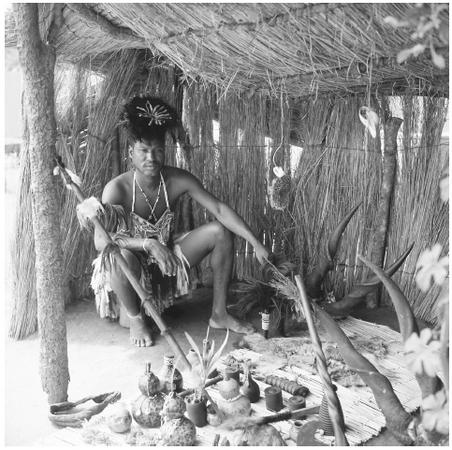
A healer from the Tonga, Zambia, sits in his grass hut. Various gourds, boxes, and other items are spread before him.
and every rural area has access to a traditional healer.
Rituals and Holy Places. The major holy places are the many waterfalls, where people believe certain spirits live. Traditional healers will often go into the woods or bush to contact spirits.
The various tribes have many rituals. For example, the Litunga tribe performs a ceremony that is called Kuomboka. This signifies the tribe's movement in the rainy season from the floodplains to higher ground. Hundreds of canoes travel down the river with the chief leading the way. Umutomboko is performed once a year by the Kazembe Bemba and is a ceremonial reenactment of a migration that took place in the early 1800s. Much dancing culminates with the chief's dance.
Death and the Afterlife. Funerals are a major event, with family members coming from great distances to attend. A funeral may last for many days, with the men outside drinking and talking, and women inside, wailing. The delay gives people traveling from long distances time to arrive. After a period, the group will proceed to a graveyard where services, usually Christian, will be held. Unfortunately, funerals have become an everyday occurrence due to the high death rate associated with AIDS and other illnesses.
There are separate ceremonies for the burial of village chiefs, along with their ancestors. A Bemba tradition is that if a paramount chief dies, his body will not be buried for a week but is protected because a clipping of his hair or a fingernail could be a very powerful item in traditional religions.
Traditional religions also have their specific beliefs on death and afterlife.
Medicine and Health Care
Under President Kaunda, the government provided basic health coverage for everyone, including those in rural areas. That, however, was when Zambia was a wealthy country and could afford to do so. Government hospitals have deteriorated significantly in the past few years with major problems of understaffing and increasing numbers of sick patients. Because of limited funding, even hospital maintenance has suffered. Medicines, particularly those for AIDS patients, are in high demand, and funding is inadequate; the situation is worse in the rural areas. The major health problems are AIDS, TB, malaria, and malnutrition.
Much of the support from NGOs and foreign governments comes in the form of medical assistance such as medicines, equipment, and personnel. There is a strong government immunization program for children in very rural areas, with traveling clinics for those five years or younger, where routine immunization shots and basic health care are distributed.
Secular Celebrations
Holidays officially celebrated by the government include: New Year's Day (1 January), Labor Day (1 May), African Freedom Day (21 May), Unity Day (in July), Heroes Day (in July), Youth Day (9 August), and Independence Day (21 October). Government offices and banks are closed on these days and there often are planned celebrations in the larger cities, including parades or festivals. Residents of the cities traditionally return to their clans for these times of celebrations.
The Arts and Humanities
Support for the Arts. Most of the support for the country's art programs comes from tourists or NGOs. Zambians produce beautifully carved pieces for the tourist trade with a sale expected to bring in quite a bit of money for a household. Basket weaving in Zambia is generally considered the best in Africa, with many different materials and styles used. The baskets are typically made out of grass reeds and are used for containers.
Literature. There are few published Zambian authors, largely because of the high illiteracy rate. Another factor is the high cost of books. The books that are written are usually stories of independence or on topics related to life in the city or the village.
Graphic Arts. At one time, a large textile industry existed in the country, owned and operated by the government. The main product was brilliantly colored dyed fabrics in many patterns. This fabric was used for clothing, particularly chitenges, which are strips of cloth. These are worn as skirts, wrapped about the bodies of women and especially popular in villages. In the 1990s, the importance of saulas, or secondhand clothing, increased, with donations from Western countries and church organizations—thus decreasing the need for new textiles.
Performance Arts. Drum and dance troupes are popular. Many of these are for the benefit of tourists and perform in major cities, since the smaller cities do not have the facilities or money to support the arts. These dances are very lively and use the traditional instruments of drums, an instrument similar to a xylophone, and a thumb piano.
Bands are also popular in urban settings. The most popular sound is rumba music from the Congo, but there is an appreciation of the traditional tribal songs and sounds. In village settings, the basics prevail. In most cases, not even an instrument is used; instead, traditional songs are sung and clapped while sitting around a community fire. The passing on of beliefs and customs in oral performances are still practiced. This is a very important part of tribal culture and preserves a tribe's identity and beliefs.
Bibliography
Baldwin, Robert E. Economic Development and Export Growth: A Study of Northern Rhodesia, 1920–1960, 1966.
Beveridge, Andrew A., and Anthony R. Oberschall. African Businessmen and Development in Zambia, 1979.
Bonnick, Gladstone G. Zambia Country Assistance Review: Turning an Economy Around, 1997.
Burdette, Marcia M. Zambia: Between two Worlds, 1988.
Cancel, Robert. Allegorical Speculation in an Oral Society, 1988.
Chiluba, Frederick J. T., Democracy: The Challenge of Change, 1995.
Crehan, Kate A. F. The Fractured Community, 1997.
De Gaay Fortman, Bastiaan, ed. After Mulungushi: The Economics of Zambian Humanism, 1969.
Epstein A. L. Urbanization and Kinship, 1981.
Fisher, W. Singleton, and Julyan Hoyte. Ndotolu, 1987.
Holmes, Timothy. Zambia, 1998.
Ihonvbere, Julius O. Economic Crisis, Civil Society and Democratization: The Case of Zambia, 1996.
Knauder, Stefanie. Shacks and Mansions, 1982.
Lancaster, Chet S. The Goba of the Zambezi, 1981.
Obidegwu, Chukwuma F., and Mudziviri Nziramasanga. Copper and Zambia: An Econometric Analysis, 1981.
Roberts, Andrew D. A History of the Bemba, 1973.
Schmetzer, Harmut. Traditional Architecture in Zambia, 1987.
Smith, Edwin W. The Ila Peoples of Northern Rhodesia, 1968.
Turner, Edith. The Spirit and the Drum, 1987.
——. Experiencing Ritual, 1992.
Turok, Ben, ed. Development in Zambia: A Reader, 1979.
Van Binsbergen, Wim M. J. Religious Change in Zambia, 1981.
